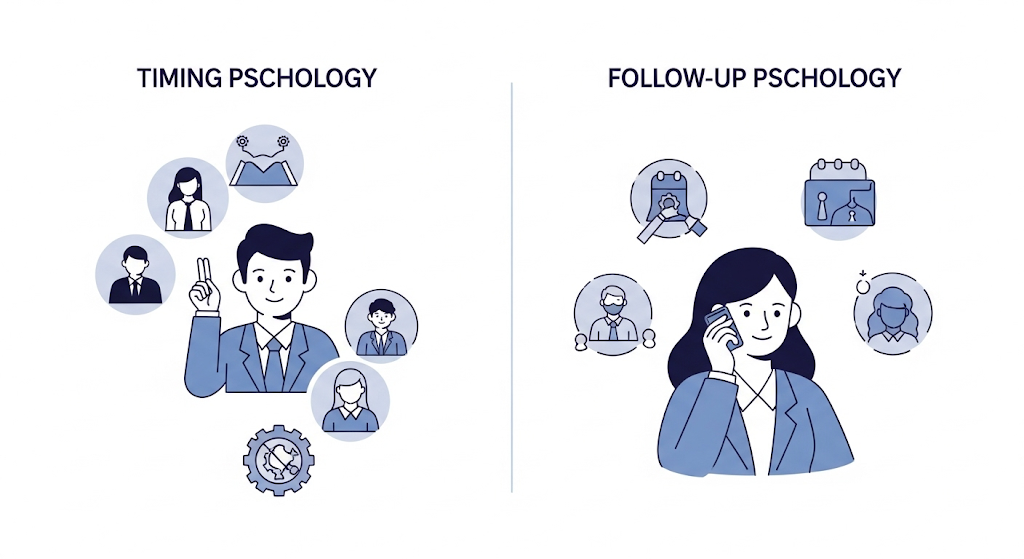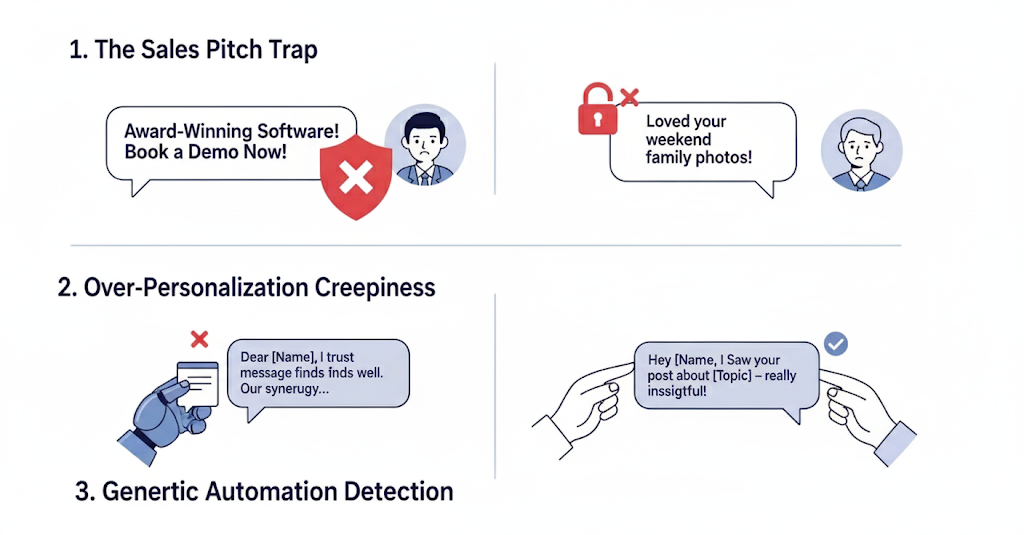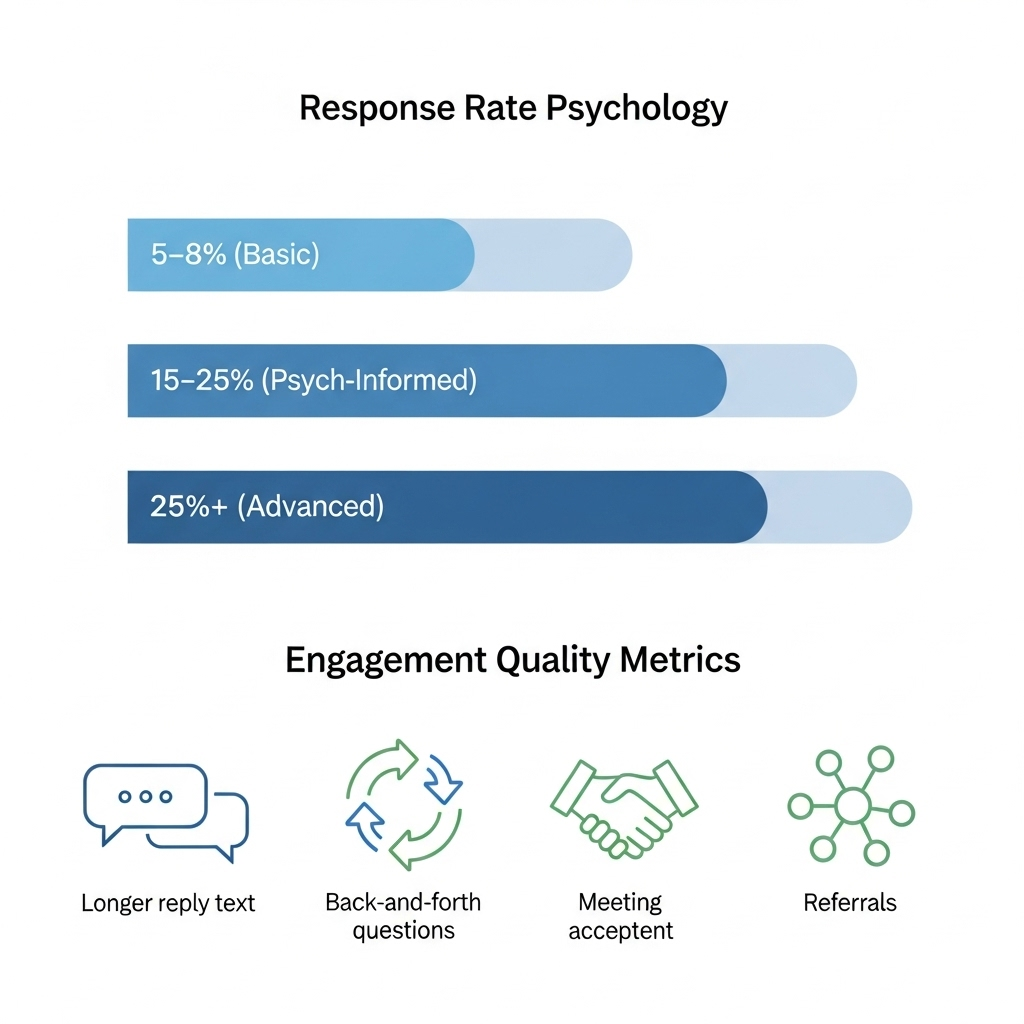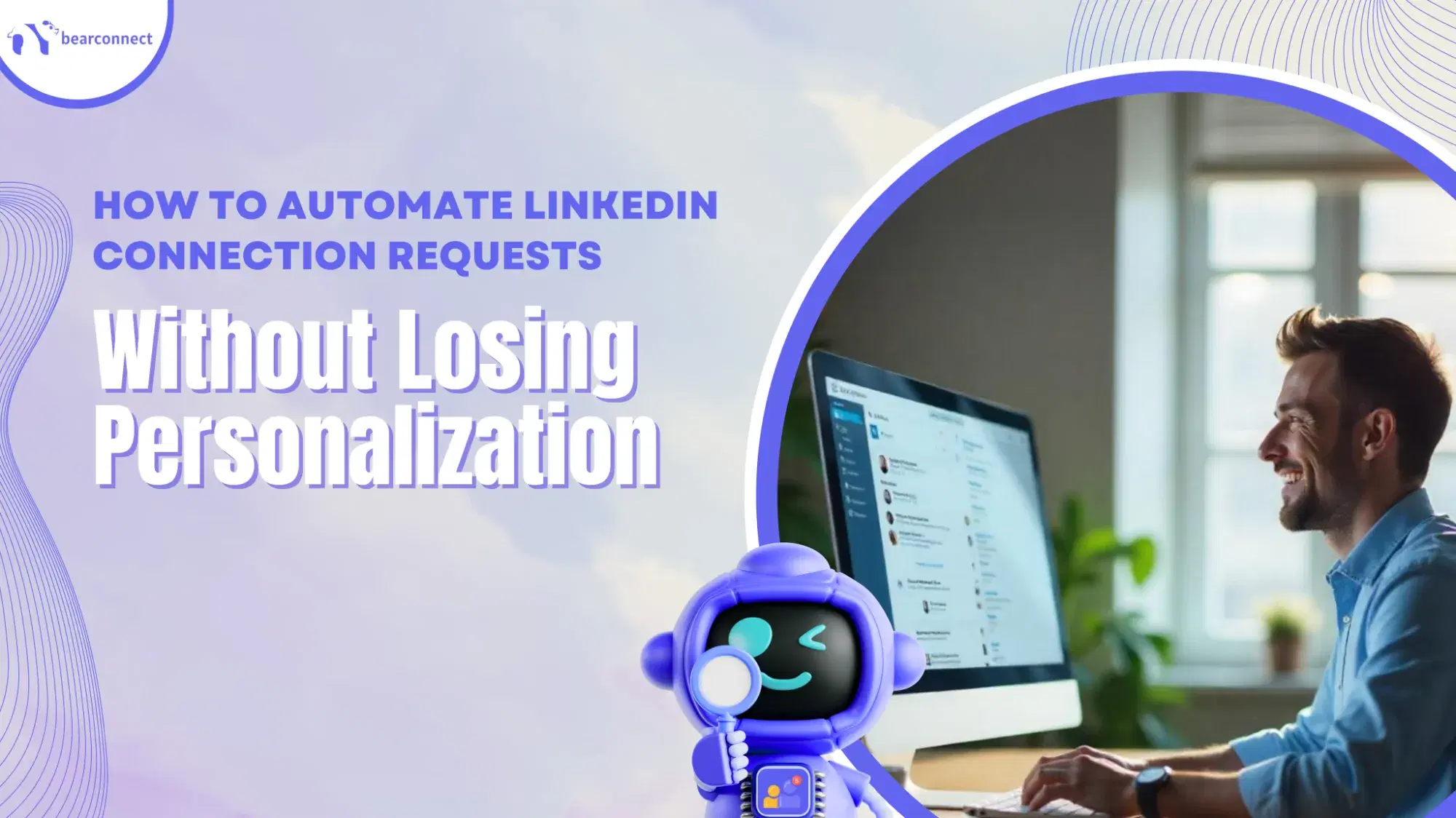The Psychology Behind Automated LinkedIn Messages That Convert

Most automated LinkedIn messages fail spectacularly, achieving response rates below 5%.
The difference between spam and conversion lies not in technology, but in understanding the psychological principles that drive human behavior.
Yet occasionally, one message stops you mid-scroll. What made that one different?
In my experience running LinkedIn outreach campaigns for SaaS and B2B teams, I have seen how automation can save hours while still keeping conversations personal if used correctly.
So, for B2B professionals, LinkedIn automation has become a double-edged sword.
The Psychology of First Impressions in Digital Communication

The Critical 7-Second Window
Your brain makes snap judgments. When you open a LinkedIn message, you decide within seven seconds whether it's worth your time.
During this brief window, your subconscious evaluates:
- Does this person seem trustworthy?
- Will this message offer genuine value?
- Is responding worth my limited attention?
Here is the main problem: most LinkedIn prospecting messages follow predictable patterns. Your brain recognizes these patterns instantly and categorizes them as spam before you consciously read the content.
Breaking Through Pattern Recognition
The best automated messages feel different from the start. They interrupt your expectations while maintaining professionalism.
When learning how to use automation on LinkedIn effectively, consider these psychological triggers:
- Get specific: Instead of "Congratulations on your recent growth," try "Saw your team just opened the Dallas office - exciting expansion into Texas markets"
- Start with questions: Replace "I hope this finds you well" with "What's driving your team's aggressive expansion this quarter?"
- Reference real connections: "Mona mentioned you are leading the digital transformation initiative there."
The goal is to make automation feel conversational, not systematic.
Manual Outreach vs. LinkedIn Automation
| Factor | Manual Outreach | LinkedIn Automation |
|---|---|---|
| Time Required | Sending 20 to 30 messages per day can take hours. | Once set up, 100 to 200+ messages can be sent daily with minimal effort. |
| Scalability | Hard to scale because output depends on individual effort and available time. | Easy to scale since outreach volume can be increased without much extra work. |
| Risk | Very low risk of account issues if done naturally. | Moderate risk if used carelessly; high activity can trigger LinkedIn restrictions. |
| Personalization | Every message can be tailored to the recipient’s profile and context. | Personalization possible with templates and variables, but may feel less authentic. |
Core Psychological Principles for Automated LinkedIn Message Conversion

1. The Personalization Psychology
When someone mentions specific details about your company or recent achievements, your brain registers the message as individually crafted. This triggers the psychological principle of perceived importance.
But here's the catch - too much personalization backfires.
LinkedIn DM automation that references your weekend posts or detailed company information can feel creepy rather than thoughtful.
The sweet spot for LinkedIn outreach automation includes:
- Recent company news or achievements
- Industry-specific challenges
- Mutual connection references
- Role-specific pain points
Keep it professional and publicly available.
2. Social Proof and Authority Building
Humans naturally follow others' behaviors. In LinkedIn messaging, this manifests through trusted recommendations and shared connections.
Your brain processes social signals like:
- Mutual connections: "Oh, they know Jennifer from marketing."
- Industry recognition: Subtle mentions of speaking at conferences or industry awards
- Client success stories: Brief references to helping similar companies
The psychology is simple: we trust people our network already trusts.
3. The Curiosity Gap Technique
Ever notice how cliffhangers keep you watching TV shows? The same psychological principle works in LinkedIn prospecting messages.
- Instead of: "can I Help you to Increase sales by 20%?"
- Try: "Noticed something interesting about your Q3 strategy that most SaaS companies in your space are missing"
This creates psychological tension that demands resolution. Your brain wants to close the loop and discover what you're missing.
4. Reciprocity Principle in Action
When someone gives you something valuable without asking for anything in return, you feel psychologically obligated to reciprocate. This is one of the strongest drivers in human behavior.
Value-first approaches that work in automated outreach:
- Share relevant industry insights
- Offer helpful resources or tools
- Provide competitive intelligence
- Make useful introductions
The key is delivering genuine value that requires minimal effort from the recipient.
For example, one client who previously sent 25 manual messages a day scaled to 200 with automation while maintaining a 32% reply rate by customizing the first line.”
Message Structure That Converts: The AIDA Psychology Framework
1. Attention: Breaking Through the Noise
Your opening line determines everything. It must immediately differentiate your message from the dozens of generic pitches your prospects receive daily.
Pattern interrupts that work:
- "Quick question about your Atlanta expansion..."
- "What is your opinion on the recent changes in data privacy laws?"
- "Your recent interview about remote sales teams got me thinking..."
Avoid corporate-speak like "Hope you are doing well" or "I came across your profile." These phrases scream automation.
2. Interest: The Value-First Approach
Once you have their attention, prove you understand their world. Interest isn't about your company - it's about their challenges and goals.
Effective interest-building for LinkedIn automation messages:
- Reference recent industry developments
- Share insights about their market position
- Demonstrate understanding of their role challenges
- Provide context showing business knowledge
Remember: they don't care about your credentials yet. They care about whether you understand their problems.
3. Desire: Building Connection Through Consultative Questions
In LinkedIn messaging, desire isn't about wanting your product. It's about wanting to continue the conversation.
Questions that build connection:
- "What's been your biggest challenge scaling the sales team this year?"
- "How is your team adapting to the move toward hybrid selling models?"
- "What's your take on the new compliance requirements affecting your industry?"
Position yourself as someone worth talking to, not someone trying to sell something.
4. Action: Low-Commitment CTAs
People say yes to small requests more easily than large ones. Your call-to-action should feel effortless.
High-converting CTAs:
- "Worth a brief chat to explore this?"
- "Open to a quick 15-minute chat next week to share thoughts?"
- "Would you be open to a short discussion on this?"
Avoid anything that sounds time-intensive or sales-heavy. You're starting a conversation, not closing a deal.
HubSpot reports that when cold outreach is personalized to address specific role challenges or recent company developments, response rates increase significantly compared to generic outreach.
Timing and Frequency: The Psychology of Perfect Moments

1. Optimal Timing Psychology
B2B professionals have predictable attention patterns. Most check LinkedIn:
- Tuesday through Thursday: Less Monday chaos, not yet Friday mode
- Morning hours (8-10 AM): Peak decision-making energy
- Early afternoon (1-3 PM): Post-lunch attention recovery
But timing varies by role. C-level executives often browse during commutes, while managers prefer dedicated work blocks.
Understanding how to automate LinkedIn messages includes mastering these timing patterns for maximum psychological impact.
2. Follow-Up Sequence Psychology
Three touchpoints build familiarity without seeming pushy. Here's the psychology:
- First follow-up (7-10 days): Add new insights or different angles
- Second follow-up (2 weeks): Reference mutual connections or industry events
- Third follow-up (3-4 weeks): Soft close with alternative contact methods
Each smart LinkedIn follow-up must provide new value. Repeating the same request feels desperate, not persistent.
Advanced Behavioral Intelligence Techniques
1. Beyond Basic Variables
The most sophisticated LinkedIn outreach tools analyze behavioral signals that reveal prospect psychology:
- Recent activity patterns: What content do they engage with?
- Connection growth: Rapid network expansion suggests growth phases
- Profile updates: Recent changes often signal new initiatives
- Content sharing: Types of posts reveal current priorities
These signals provide insights into mindset and timing that demographics alone cannot.
2. Reading Digital Body Language
Just like face-to-face interactions, digital behavior reveals psychological states:
- Frequent content sharing indicates thought leadership aspirations
- Job changes suggest openness to new solutions
- Event attendance shows learning priorities
- Industry group participation reveals focus areas
This behavioral intelligence enables messaging that aligns with prospect psychology rather than just job titles.
When evaluating automation platforms, look for tools that prioritize behavioral intelligence over basic demographic filtering. Platforms like Bearconnect focus on helping users implement these psychological principles rather than just sending more messages faster.
Common Psychological Mistakes That Kill Conversion

1. The Sales Pitch Trap
Leading with company achievements triggers immediate psychological resistance. Your prospect's brain activates defensive mechanisms the moment they detect sales intent.
Avoid these conversion killers in LinkedIn DM automation:
- Opening with credentials or awards
- Focusing on features instead of benefits
- Using promotional language and superlatives
- Rushing toward demos or meetings
Focus on their world first. Let them discover your credibility through value delivery.
2. Over-Personalization Creepiness
There's a fine line between thoughtful research and invasive stalking. Automated connection requests referencing too many personal details trigger privacy concerns.
Stay away from:
- Personal social media activity
- Family information or hobbies
- Detailed website browsing behavior
- Private company information
Stick to professional, publicly available information that demonstrates legitimate business interest.
3. Generic Automation Detection
Your prospects quickly identify LinkedIn automation messages through telltale signs:
- Perfect grammar that sounds robotic
- Unnatural phrasing or word choices
- Systematic timing patterns
- Predictable template structures
The best automated messages include subtle imperfections that feel human while maintaining professionalism.
Measuring Psychological Impact: Analytics That Matter

1. Response Rate Psychology
Response rates reveal how well your messaging resonates psychologically:
- 5-8%: Typical for basic LinkedIn outreach automation
- 15-25%: Achievable with psychologically-informed messaging
- 25%+: Possible with advanced behavioral targeting
But response rate alone doesn't tell the whole story. A 10% response rate with hostile replies isn't success.
2. Engagement Quality Metrics
Look beyond response rates to understand the psychological connection:
- Response length: Longer replies indicate higher engagement
- Question reciprocity: When prospects ask questions back
- Meeting acceptance rates: Willingness to invest time
- Referral generation: Introductions to colleagues
These metrics reveal whether you're creating the genuine connections or just surface-level responses.
To put this in perspective, Belkins recently published data showing that most LinkedIn outreach campaigns have response rates around 6.4–6.9%
The Future of Psychologically-Driven Automation
LinkedIn prospecting automation is evolving from demographic spray-and-pray toward behavioral intelligence. The winning approaches combine human psychological insight with AI-powered pattern recognition.
Emerging trends include:
- Real-time behavioral analysis: Optimal timing based on activity patterns
- Psychological profiling: Message style adapted to personality indicators
- Sentiment analysis: Tone adjustments based on recent engagement
- Predictive psychology: Identifying readiness signals before outreach
The key is maintaining authenticity while leveraging technology for psychological insight, not just operational efficiency.
Conclusion
The psychology behind LinkedIn automation messages that convert centers on understanding fundamental human needs: recognition, value, and authentic connection. When you master how to automate LinkedIn messages that acknowledge specific situations, provide genuine value, and invite real conversation, you're not automating relationships - you're automating the discovery of people worth building relationships with.
Remember, your prospects receive dozens of LinkedIn outreach messages weekly. The ones that convert don't sound automated at all. They sound like the beginning of conversations worth having.
Frequently Asked Questions
Q1: How can I make my automated LinkedIn messages sound more human?
Focus on subtle imperfections and conversational language. Avoid overly polished grammar, use contractions, and reference specific, recent details about their company. Include natural questions that show genuine curiosity rather than following rigid templates.
Q2: What is the ideal length for automated LinkedIn messages?
Keep your first LinkedIn outreach message short — ideally 50-150 words. Long enough to provide value and context, but brief enough to read quickly. Most people scan LinkedIn messages in under 10 seconds, so front-load the most important information.
Q3: How many follow-up messages should I send before giving up?
Three touchpoints work best for LinkedIn DM automation. Send the first after 7-10 days with a new value, the second after 2 weeks with a different angle, and the third after 3-4 weeks as a soft close. More than three follow-ups typically damage relationships rather than build them.
Q4: Is it safe to use LinkedIn automation tools without getting banned?
Yes, when you use LinkedIn outreach automation responsibly. Stay within LinkedIn's daily limits (20-50 connection requests and 100-200 messages daily), avoid generic templates, space out activities naturally, and focus on quality targeting rather than volume. The key is mimicking human behavior patterns.
Q5: What psychological triggers work best for B2B LinkedIn outreach?
The most effective triggers for LinkedIn prospecting messages are curiosity gaps (creating intrigue without revealing everything), social proof (mutual connections and industry recognition), reciprocity (providing value first), and personalized acknowledgment (referencing specific achievements or challenges). Combine 2-3 triggers per message for maximum impact.
Author bio:
Written by Mona Juneja, a B2B Sales Strategist with over 20+ years of sales experience at big names like Microsoft, Oracle, and DELL. I helped multiple Agencies streamline prospecting workflows, improve connection rates, and generate consistent sales-qualified leads through automation.
Ready to Transform Your LinkedIn Strategy?
Join thousands of professionals already using Bearconnect to automate their outreach and grow their network.
7-day free trial • Cancel anytime
Related Articles

How Does LinkedIn Automation Actually Work Behind the Scenes?
Ever wondered how top sales professionals manage to send 200+ personalized LinkedIn messages daily while still having time for calls and meetings? The secret lies in understanding how LinkedIn automation actually works behind the scenes. As a sales development representative, you've probably heard colleagues mention their "automation setup" or seen competitors seemingly everywhere on LinkedIn. But what's really happening when you click "start campaign" on automation tools? This deep dive rev

How to Automate LinkedIn Connection Requests Without Losing Personalization
Are you tired of sending LinkedIn connection requests manually? You’re not alone. Most modern professionals want to grow their network quickly, but nobody wants to sound robotic or spammy. That’s exactly where LinkedIn automation comes in, but here’s the catch: if you automate and lose the personal touch, your requests end up ignored or, worse, flagged as spam. In this guide, we’ll explore how you can embrace LinkedIn automation, keep your outreach human and compelling, and build a network that